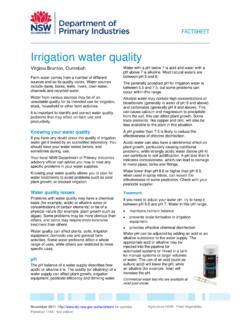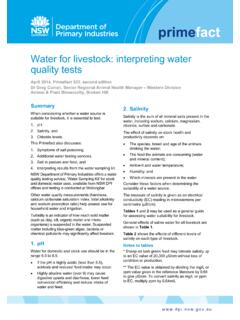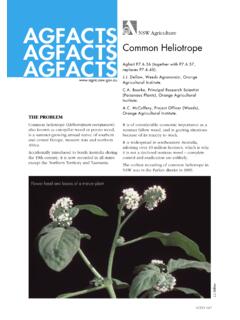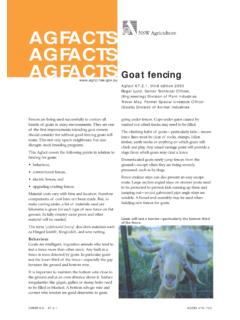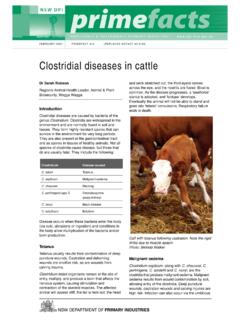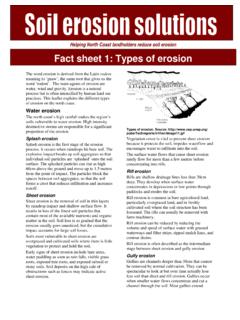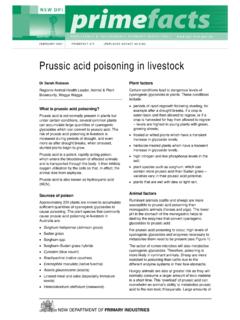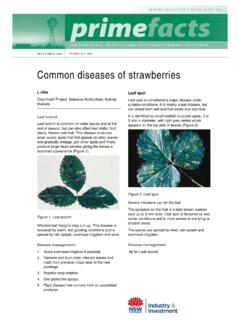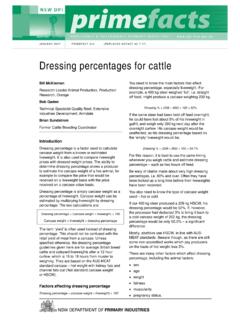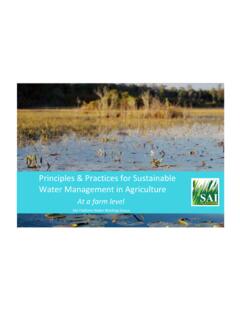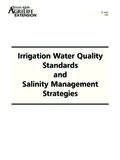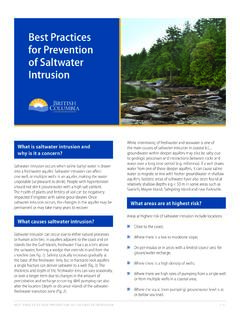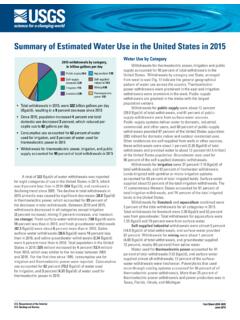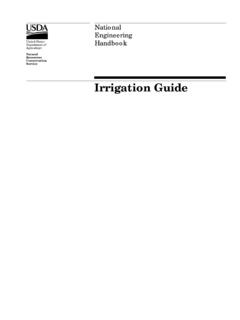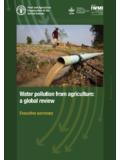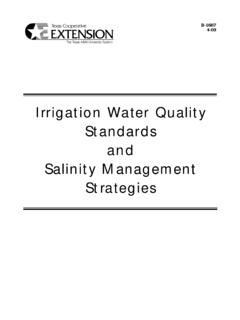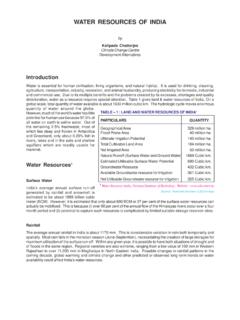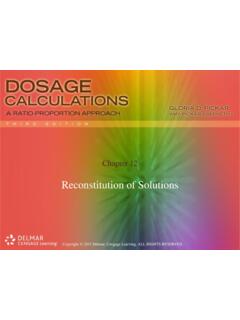Transcription of Irrigation salinity – causes and impacts
1 OCTOBER 2009 PRIMEFACT 937 Irrigation salinity causes and impactsCynthia Podmore Advisory Officer, Natural Resource Advisory Services, Wagga Wagga What is Irrigation salinity ? salinity is the accumulation of salts (often dominated by sodium chloride) in soil and water to levels that impact on human and natural assets ( plants, animals, aquatic ecosystems, water supplies, agriculture and infrastructure). Irrigation salinity occurs in irrigated landscapes (Figure 1). Primary and secondary salinity Primary (or inherent) salinity is the natural occurrence of salts in the landscape for example salt marshes, salt lakes, tidal swamps or natural salt scalds. Secondary salinity is salinisation of soil, surface water or groundwater due to human activity such as urbanisation and agriculture (irrigated and dryland). Salt sources Salt may come from several sources including: aeolian or wind borne salt from ocean spray or sedimentary deposits including dune sand and clay particles from the rivers and lakes of the Murray-Darling Basin cyclic salt from ocean spray or pollution dissolved in rainwater then deposited inland connate or fossil salt incorporated in marine sediments at the time of deposition, during periods when Australia was partly covered by sea rock weathering that allows salt to be released as minerals break down over time.
2 The hydrological cycle The hydrological cycle is the movement of water from the atmosphere to the earth and back again. Salts are highly soluble, so water is the key to the movement of salts in the landscape. Figure 1. causes of Irrigation salinity . Source: Slinger & Tenison (2007). 2 PRIMEFACT 937, Irrigation salinity causes AND impacts The groundwater system The watertable is the surface below which all the spaces in soil and rock are filled with water . water in this saturated zone is called groundwater. Above this is the unsaturated zone where the spaces are dry or only partially filled with water . water moving downwards past the plant root zone is called leakage. water may leak from rivers, streams, dams and Irrigation channels. Leakage that reaches the saturated zone is called groundwater recharge and groundwater that leaves the saturated zone is called groundwater discharge. Recharge areas are usually up-slope of discharge areas. When groundwater is at or near the soil surface discharge occurs as seepage, springs, and base flow to streams allowing groundwater to evaporate and/or be evapotranspired.
3 causes of Irrigation salinity Irrigation salinity occurs due to increased rates of leakage and groundwater recharge causing the watertable to rise. Rising watertables can bring salts into the plant root zone which affects both plant growth and soil structure. The salt remains behind in the soil when water is taken up by plants or lost to evaporation. Recharge rates in Irrigation areas can be much higher than dryland areas due to leakage from both rainfall and Irrigation . This causes potentially very high salinisation rates. Watertables within two metres of the soil surface indicate the potential for salts to accumulate at the soil surface. Inefficient Irrigation and drainage systems are a major cause of excess leakage and increase the risk of salinity and waterlogging in Irrigation areas. Poor water distribution on paddocks results in some areas being under-irrigated, causing salts to accumulate (where watertables are high) and other areas being over-irrigated and waterlogged. Groundwater mounds can develop under Irrigation areas as a result of leakage from inefficient systems and restrictive layers.
4 This puts pressure on the regional groundwater system forcing saline groundwater into waterways. Irrigating with saline water adds salt to the soil and increases the need for applying more Irrigation water to leach salts past the plant root zone. Salt affects plants through: 1. direct ion toxicity to plant tissue leaf burn 2. altered nutrient interactions reduced availability of some elements 3. influence on osmosis plants have difficulty extracting soil water . Continual under- Irrigation also increases salinity as salts contained in the Irrigation water need to be flushed or leached periodically to prevent them accumulating to levels that limit productivity. Inappropriate matching of crop, soil type and Irrigation method can also cause excessive leakage. For example, irrigating high water -use crops using inappropriate Irrigation methods should not be carried out on permeable soils (high sand content). Other factors which influence leakage rates include soil type (Figure 2), climate and the amount (or removal) of deep-rooted perennial vegetation.
5 Replacing deep-rooted perennial pasture with irrigated annual crops reduces the level of evapotranspiration as rates are low following cultivation and during fallow periods. As a result, more water will infiltrate the soil profile and enter the watertable. Figure 2. The permeability of different soil textures influences leakage rate to the groundwater system. Source: Slinger & Tenison (2007). The effect of salt on plants and soil The effect of salt on plants As salts accumulate in saline discharge areas they can reach levels that affect plants in a number of ways. This leads to poor plant health, a loss of productive species and dominance of salt-tolerant species. Osmotic effect Under normal conditions, plants readily obtain water from the soil by osmosis (movement of water from a lower salt concentration outside the plant to a higher salt concentration in the plant). As soil salinity increases this balance shifts making it more difficult for plants to extract water . Toxic effect Plant growth can be directly affected by high levels of toxic ions such as sodium and chloride.
6 Excess sodium accumulation in leaves can cause leaf burn, necrotic (dead) patches and even defoliation. Plants affected by chloride toxicity exhibit similar foliar symptoms, such as leaf bronzing and necrotic spots in some species. Defoliation can occur in some woody species. Ionic imbalance An excess of some salts can cause an imbalance in the ideal ratio of salts in solution and reduce the ability of plants to take up nutrients. For example, relatively high levels of calcium can inhibit the uptake of iron ( lime induced chlorosis ), and high sodium can exclude potassium. salinity tolerance Salt-tolerant plants (halophytes) can tolerate high internal concentrations of salts and take up salt with water . Examples include saltbush (Atriplex species) and bluebush (Maireana species). Salt-resistant plants (glycophytes) cannot tolerate salt internally and exist in saline environments by excluding salt at their roots. Most agricultural plants fall into the salt-resistant category of glycophytes.
7 They can maintain growth in mildly saline soil by excluding salts at the roots (Greenway and Munns 1980). However, in extremely saline soils glycophytes are unable to both exclude salt and obtain sufficient water for maintenance (QDNR 1997).The impact of salinity varies with plant species, stage of growth, management practices, varieties and soil fertility. Effect of waterlogging on salinity tolerance Waterlogging exacerbates the effect of salinity . Waterlogged plant roots are unable to exclude sodium and chloride due to the increased rates of transport of these ions, and concentrations in the plant shoot increase. Poor aeration also affects soil biology responsible for converting nutrients to their plant available form, causing nutrient deficiencies. The effect of salt on soil Highly saline soils often become highly sodic. The ion imbalance and effect on the soil will depend on the type of salt present. Sodium and magnesium ions can destroy soil structure whereas calcium carbonate may improve soil structure (due to calcium) and increase soil pH (due to carbonate).
8 Highly saline soils may have dark greasy patches where organic matter has been destabilised. On very salty sites a complete loss of groundcover and visible salt crystals often occur on the soil surface making it vulnerable to erosion. impacts of Irrigation salinity In the Irrigation areas of NSW an estimated 4800 ha are affected by salinity (Tenison 2009). The areas most at risk include: Murrumbidgee Irrigation Areas near Griffith Murray Irrigation Areas around Deniliquin Jemalong Irrigation District west of Forbes. The impacts of Irrigation salinity are much the same as for dryland salinity . They include agricultural, environmental and social impacts . Agricultural Direct costs of increasing salinity to agricultural producers include: reduced agricultural production (Figure 3) reduced farm income reduced options for production reduced access and trafficability on waterlogged land reduced water quality for stock, domestic and Irrigation use damage to and reduced life of farm structures such as buildings, roads, fences and underground pipes and services reduced productivity of agricultural land animal health problems saline water supply farm machinery problems (bogging, rusting) breakdown of soil structure, increased erosion and nutrient loss loss of beneficial native flora and fauna decreased land value.
9 Figure 3. Leaf burn in rice crops irrigated with highly saline water . saline water application over 2 dS/m ECW will result in rice yield decline. Source: Slinger & Tenison (2007). Environmental Environmental impacts from land and stream salinity include: decline of native vegetation and loss of habitat loss of nesting sites and decline in bird populations decline in wildlife fauna other than birds reduced food for wildlife populations increased soil and wind erosion reduced wetland habitat and decline in fish and aquatic populations PRIMEFACT 937, Irrigation salinity causes AND impacts 3 4 PRIMEFACT 937, Irrigation salinity causes AND impacts reduced aesthetic value reduced recreational and tourism values reduced biodiversity in stream fauna, riparian vegetation and wetlands increases in weeds and undesirable changes in plant populations (Figure 4) damage to state/national parks and wildlife sanctuaries. Figure 4. Species tolerant of waterlogging, for example Pin rush, become dominant.
10 Source: Slinger & Tenison (2007). Social impacts on the framework and structure of our society from increasing salinity include: reduced aesthetic value of the landscape (Figure 5) reduced recreational and tourism values reduced agricultural incomes due to productivity losses flow-on impact on employment reduced regional population (in both rural and urban communities) increased pressure for consolidation of agricultural properties reduced service levels to regional towns (especially <5000 persons) increased social adjustment costs welfare, marriage breakdown and bankruptcy. Figure 5. salinity induced by poor drainage and Irrigation layout. Source: Slinger & Tenison (2007). Further reading Primefact 936, Dryland salinity causes and impacts Primefact 938, Urban salinity causes and impacts Primefact 939, salinity symptoms References DNRQ (1997) salinity Management Handbook. Department of Natural Resources Queensland. Greenway, H. and Munns, R.
